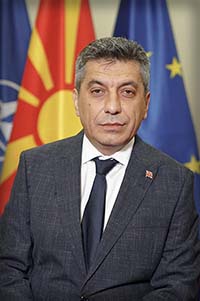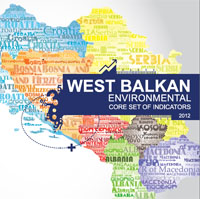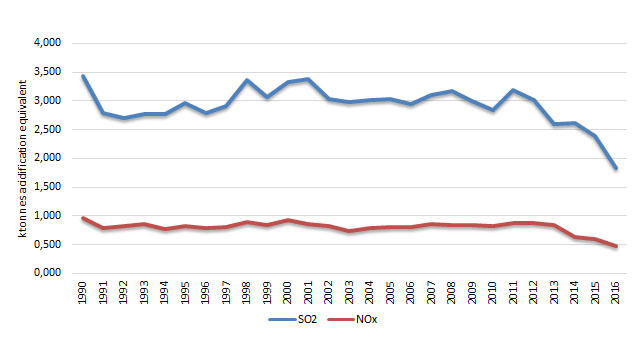| EMISSIONS OF ACIDIFYING SUBSTANCES |
The indicator tracks the trends in anthropogenic emissions of acidifying substances, i.e. acidifying processes in the air. These substances include nitrogen oxides, ammonia, and sulphur dioxide, and their acidifying power is weighted by their acidifying potential.
The indicator also provides information on emissions by sectors: energy generation and transformation, road and other transport, industry (processes and energy), fugitive emissions, waste, agriculture and other.
- kt (acidifying equivalent)
What progress has been made in overall reducing acidifying substances emissions in the air?
Sulfur dioxide (SO2)
The key sector of this polluting substance is energy production and distribution. Compared to the trend in 1990, emissions of sulfur dioxide changed in 2016 (reduction by 47% compared to 1990), but the trend was variable due to changes in the consumption of coal in energy sector. In the period from 2012 until today the trend of decline of SOx starts due to the reduced consumption of coal and heavy oil in the thermal power plants. . Nevertheless, there was no significant reduction compared to other European countries, due to the fact that the best available techniques were not applied in the energy producing installations for reduction of sulfur oxides as substances originating from the use of coal with high content of sulfur. On the other side, SO2emissions from fuels combustion in industry and administrative facilities owing to use of crude oil with sulfur content up to 1%. Yet, this reduction did not contribute to significant reduction in overall emissions considering that the share of emissions from electricity producing installations in 2016 was around 86%. Significant reduction in this polluting substance is expected upon the introduction of a desulfurization process in the largest electricity producing plant REK Bitola, planned to be implemented in accordance with the time dynamics, set out in the National Plan for reduction of emissions from large combustion plants.
Nitrogen oxide (NOx)
The key sectors for this pollutant are energy production and distribution, and road transport. Total national emissions of NOx in 2016 are 21,6 kt.The trend of emissions during the reporting period was not stable and depended mainly on the consumption of fuels in the energy sector. The reasons for the reduction during the last several years are related to significantly reduced emissions from the industry for electricity production, owing to reduced scope of operation in REK Oslomej and modernization of boilers in REK Bitola as well as lower fuel consumption in the sector. As a result of the old vehicle fleet (around 79% of cars belong to EURO classes 0-2), there was no significant reduction in the emission of this pollutant from road transport. At the same time, due to the availability of detailed data for the fleet, for the last few years for the period 2014-2016, a methodology for calculation of emissions at level 2 is applied, while for the previous years the calculations were performed in the application of the methodology at level 1. Greater progress in the reduction of NOx emissions is expected with renewal of the fleet and with the increasing of the share of renewable sources in electricity production.
Diagram 1. Emission trends for nitrogen oxides and sulfur dioxide
Under the CARDS Programme, the Inventory of air emissions of the main pollutants in the country was established in 2005, in accordance with the EMEP methodology by individual sectors, i.e. activities, and in 2014 an Inventory including all pollutants was prepared.Starting from 2014, the Republic of Macedonia carries out calculations of national emissions for all pollutants.
The emission sources, within this national indicator, are made according to the following categorization:
| Sector |
| Energy Production and distribution |
| Commercial, instiucional and households |
| Industry (combustion) |
| Industry (production) |
| Fugitive emissions |
| Use of solvents and products |
| Road transport |
| Non-Road transport |
| Waste |
| Agriculture |
| Other |
For ozone precursors, nitrogen oxides, the main sources of emissions in 2016 were the following SNAP categories of sources: Road transport with a share of 31% (22% in 1990) and Energy production and distribution with a share of 41% in the overall national emissions of NOx.
As far as sulfur dioxide is considered, almost all emissions of SO2 originate from Energy production and distribution (86%). Around 11% of overall national emissions of SO2 originate from combustion processis in manufacturing industry.
Which different sectors and processes contribute to acidifying substances emissions?
Diagram 2. Total SOx emissions by sectors on annual level
The sector is the key sector in sulfur oxides emission. In 2013 and 2014, approximately the same emissions of sulfur oxides were recorded which were lower than in 2011 and 2012 due to the lower capacity of operation of the thermal power plant REK Oslomej. In general, it may be concluded that in the entire reporting period. A key source is the sector of Energy production and distribution, on average, with share of 80-90% in the entire reporting period.
Diagram 3. Total NOx emissions by sectors on annual level
Data coverage: excel
Source of data: The data used refers to overall national emissions and emissions categorized by NFR delivered to “Eionet Central Data Repository” by EEA member and collaborating states to EEA and Parties to CLRTAP. Data is accessible per country on the following web address:http://cdr.eionet.europa.eu/mk/un/clrtap/inventories/envwovm7g/
- Methodology for the indicator calculation
The methodology for this indicator calculation is based on aggregation and calculation of data on SO2 and NOx emissions at annual basis, on national level, both as overall and distributed to sectors, i.e. activities.
Calculations are in line with the Guidelines of UNECE/EMEP Convention on Long-Range Transboundary Air Pollution (LRTAP Convention), as well as application of the SNAP – selective nomenclature of air pollution. With regard to this specific indicator, factors have been used in order to express the acidifying property potential. These factors are for NOx 0,02174 and for SO2 0,03125. The results are expressed in kilotonnes equivalent acidity.
Uncertainty
- Methodological and data uncertainty
Use of factors of the acidifying property potential leads to some uncertainty. Furthermore, national emission factors obtained by measurements in the Republic of Macedonia are used only in energy sector. For other sectors, standard emission factors from the EMEP/EEA Guideline are used for the inventory of air pollutants. It has been assumed that the factors are representative for Europe as a whole; different factors may be estimated at local level. Comprehensive discussion on uncertainty of these factors can be found in deLeeuw (2002). As far as activity installment is concerned, uncertainty arises from data taken from Statistical Yearbook and other sources. Definition of activity installment which is not required form, expert estimations containing uncertainty are made.
- Reference of used methodology
EMEP/EEA Guideline for inventory of air pollutant emissions 2013, Technical Report no. 09/2009, ЕЕА.
EMEP/EEA Guideline for inventory of air pollutant emissions 2013, Technical Report no. 12/2013, ЕЕА.
EMEP/EEA Guideline for inventory of air pollutant emissions 2013, Technical Report no. 21/2016, ЕЕА.
List of relevant policy documents
Action Plan for European Partnership, as well as National Plan for approximation of the national legislation with European regulations specifying bylaws that need to be prepared has been adopted.
The National Environmental Action Plan (NEAP II) has been adopted. It contains the measures that need to be taken to improve the overall status of air quality, including the reduction of emissions of acidifying substances. The National Plan for Ambient Air Protection for the period 2012 to 2017 and the National Programme for gradual air emissions reduction by 2020 have been adopted in order to define and implement measures on national level concerning introduction of renewable energy sources, application of the code of good agricultural practice, technical control of vehicles at registration, application of the best available techniques in industrial facilities, etc. At the same time, for the purpose of air quality improvement in certain local self-government units (LSGUs), all 8 Protocols to the Convention on Long-Range Transboundary Air Pollution (CLRTAP) were ratified in 2010. With regard to the last three Protocols, i.e. Protocol on heavy metals, Protocol on POPs and Gothenburg Protocol, National Action Plan for Ratification and Implementation was adopted at their request. Due to the requirement for modifications of national totals related to emissions in baseline year (1990) and national emission ceilings for 2010, the Gothenburg Protocol and Protocol on sulfur of 1995 entered into force for the Republic of Macedonia in 2014, upon the adoption of the values specified in Annex II to these Protocols.
In order to fulfill one of the basic requirements under the Protocols to CLRTAP, Inventory of Air Pollution is prepared on regular annual level by EMEP/EEAMethodology and the prepared inventory is reported to UNECE and CLRTAP and European Environmental Agency. With regard to fulfillment of the requirements of the Stockholm Convention covering the same pollutants specified in the Protocol on POPs, the National Implementation Plan for old and new organic pollutants was updated and Inventory of old and new POPs chemicals was prepared.
Legal basis
The Law on Ambient Air Quality was adopted in August 2004 and amended several times afterwards (Official Gazette of RM no. 67/2004, 92/2007, 83/2009, 35/10, 47/11, 100/12, 163/2013,10/2015 и 146/2015) as framework law in the area of air. The goals of this Law include avoiding, prevention and reduction of harmful effects on human health and environment as a whole, prevention and abatement of pollutions leading to climate change, as well as provision of appropriate information on the quality of ambient air.
On the basis of the Law on Ambient Air Quality, 16 bylaws were prepared and adopted to introduce limit values for air quality and air emissions, methodology of air quality and air emissions monitoring, manner of preparation of planning documents for air protection against pollution, manner of informing the citizens and international organizations, etc.
With reference to air standards transposed in part of the mentioned rulebooks, all ISO and CEN standards and their amendments in the area of air emissions and air quality were adopted by means of endorsement method.
Other legislation related to the regulation of air quality and air emissions regulation includes the Law on Vehicles, Law on Standardization, Rulebook on liquid fuels quality with national standards for liquid fuels quality, etc.
Does any of the national documents set targets or targets set under international documents should be achieved?
National documents listed as references in the above text provide guidelines and specify actions that should be undertaken as a matter of priority. It is important to mention that the transposition of Directives 96/61/ЕC, 2000/81/ЕC, 2000/76/ЕC, 99/13/ЕC and 2001/81/ЕC into the national laws and bylaws ranges between 90-100%, while activities towards their implementation are in progress.
In accordance with the requirements of the UNECE Convention on Long-Range Transboundary Air Pollution, inventory based on the CORINAIR Programme has been introduced; setting the target of regular inventory of pollutants in tons per year following the n-2 principle, where n is the current year.
Also, in accordance with Directive 2001/81/ЕC, as well as Gothenburg Protocol, the ceilings of the amounts of emissions have been set at the level of the Republic of Macedonia for 2010 that shall not be exceeded at annual level. The Executive Body of the Convention on Long-Range Transboundary Air Pollution, upon submission of the values of national ceilings in order to enrol the Republic of Macedonia in Annex II of the Gothenburg Protocolrequested correction of the values considering the reported data on air emissions of the pollutants sulfur dioxide and ammonia at national level. Changes in the values of these pollutants were incorporated in the Rulebook amending the Rulebook on upper limits – emission ceilings of pollutants for the purpose of setting projections for certain period concerning reduction of the quantities of pollutant emissions at annual level published in July 2014. In 2016, national emissions ceilings for SO2 and NOx were not exceeded.
| Upper limit – ceiling | Total emissions-2016 | |
| SO2 | 110 Gg | 58.7 Gg |
| NOx | 39 Gg | 21.6 Gg |
With regard to targets – emission projections for NOx for 2020, they amount 23.8Gg, and this target has been achieved in 2016.
As far as achievement of targets – projections for SOx by application of model, this target (under the applied GAINS model) for 2020 is 15 kilotons. This projection would be achieved is the National Emission Reduction Plan (NERP) is implemented in accordance with the Decision of the Ministerial Council of the Energy Community (D/2013/05/MC-S-end) concerning restriction of emissions of certain air pollutants from large combustion plants (LCP) which is currently under review to be adopted by the Energy Community in September this year.The plan defines national borders – the ceilings for large combustion plants for 2018, 2023 and 2027 which was approved by the Energy Community and the revised plan was adopted by the Government of the Republic of Macedonia in December 2017. Starting from January 2019, Republic of Macedonia should report on the quantities of total emissions resulting from large combustion plants in order to determine the compliance with the defined ceilings in the NERP.
Achievement of the targets for reduction of acidifying pollutants emissions which at the same time cause degradation of environment, materials and negative effect on human health is dependent on the adoption and implementation of all planned documents under the National Programme for Approximation with the EU Acquis.
- Reporting obligations under multilateral agreements – UNECE/CLRTAP and ЕЕА
- Annual report of processed data on environment
| Code | Title of the indicator | Compliance with CSI ЕЕА or other indicators | Classification by DPSIR | Type | Linkage with area | Frequency of publication | |
| MK NI 001 | Emissions of acidifying substances | CSI 001 | Emissions of acidifying substances | P | B |
|
annually |








































































